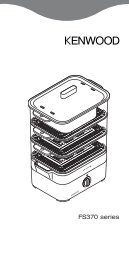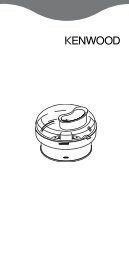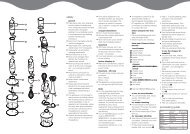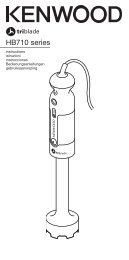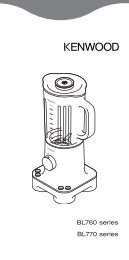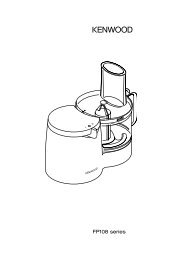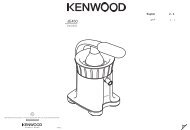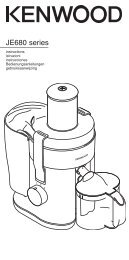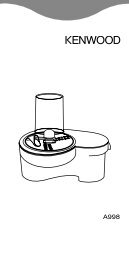Untitled - Kenwood
Untitled - Kenwood
Untitled - Kenwood
Create successful ePaper yourself
Turn your PDF publications into a flip-book with our unique Google optimized e-Paper software.
troubleshooting guide<br />
Following are some typical problems that can occur when making bread in your bread maker. Please review the<br />
problems, their possible cause and the corrective action that should be taken to ensure successful bread making.<br />
PROBLEM POSSIBLE CAUSE SOLUTION<br />
LOAF SIZE AND SHAPE<br />
1. Bread does not rise<br />
enough<br />
2. Flat loaves,<br />
no rising.<br />
3. Top inflated -<br />
mushroom-like in<br />
appearance.<br />
4. Top and sides cave in.<br />
5. Gnarly, knotted top -<br />
not smooth.<br />
• Wholemeal breads will be lower than<br />
white breads due to less gluten<br />
forming protein in whole wheat flour.<br />
• Not enough liquid.<br />
• Sugar omitted or not enough added.<br />
• Wrong type of flour used.<br />
• Wrong type of yeast used.<br />
• Not enough yeast added or too old.<br />
• eco cycle chosen.<br />
• Yeast and sugar came into contact<br />
with each other before kneading cycle.<br />
• Yeast omitted.<br />
• Yeast too old.<br />
• Liquid too hot.<br />
• Too much salt added.<br />
• If using timer, yeast got wet before<br />
bread making process started.<br />
• Too much yeast.<br />
• Too much sugar.<br />
• Too much flour.<br />
• Not enough salt.<br />
• Warm, humid weather.<br />
• Too much liquid.<br />
• Too much yeast.<br />
• High humidity and warm weather may<br />
have caused the dough to rise too fast.<br />
• Not enough liquid.<br />
• Too much flour.<br />
• Tops of loaves may not all be perfectly<br />
shaped, however, this does not affect<br />
wonderful flavour of bread.<br />
23<br />
• Normal situation, no solution.<br />
• Increase liquid by 15ml/3tsp.<br />
• Assemble ingredients as listed in recipe.<br />
• You may have used plain white flour<br />
instead of strong bread flour which has<br />
a higher gluten content.<br />
• Do not use all-purpose flour.<br />
• For best results use only fast action<br />
“easy blend” yeast.<br />
• Measure amount recommended and<br />
check expiry date on package.<br />
• This cycle produces shorter loaves. This<br />
is normal.<br />
• Make sure they remain separate<br />
when added to the bread pan.<br />
• Assemble ingredients as listed in recipe.<br />
• Check expiry date.<br />
• Use liquid at correct temperature for<br />
bread setting being used.<br />
• Use amount recommended.<br />
• Place dry ingredients into corners of pan<br />
and make slight well in centre of dry<br />
ingredients for yeast to protect it from<br />
liquids.<br />
• Reduce yeast by 1 /4tsp.<br />
• Reduce sugar by 1tsp.<br />
• Reduce flour by 6 to 9tsp.<br />
• Use amount of salt recommended in<br />
recipe.<br />
• Reduce liquid by 15ml/3 tsp and yeast<br />
by 1 /4 tsp.<br />
• Reduce liquid by 15ml/3tsp next time or<br />
add a little extra flour.<br />
• Use amount recommended in recipe or<br />
try a quicker cycle next time.<br />
• Chill the water or add milk straight from<br />
the fridge<br />
• Increase liquid by 15ml/3tsp.<br />
• Measure flour acurately.<br />
• Make sure dough is made under the<br />
best possible conditions.



